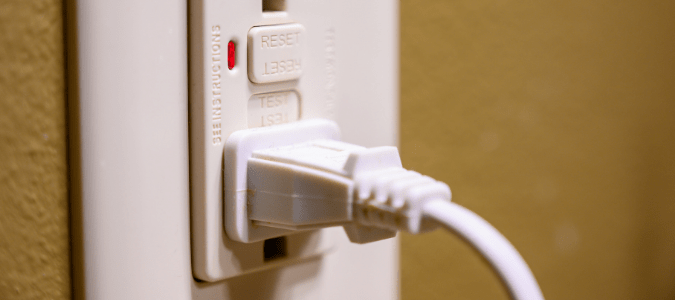While electricity is a must-have at home, it comes with safety concerns. Fortunately, GFCIs or ground fault circuit interrupters significantly reduce the risk of getting shocked or electrocuted. According to the Electrical Safety Foundation International (ESFI), electricity-related accidents have fallen by 80% since the 1970s because of these quick-to-react outlets. Today, the law requires GFCIs in all new homes. It is also a good idea to have them installed in older houses.
Here’s everything you need to know about GFCIs, including what they are, how they work and how to troubleshoot issues.
What Is a GFCI Outlet and How Does It Work?
Before learning how a GFCI works, it helps to define what ground faults are first. Electricity runs through insulated wires to reach wall outlets, switches and appliances inside our homes. But when it is in its raw state, it is impossible to control how electricity behaves. As shown by lightning, electricity tends to hurry directly to the ground.
The same happens when the electric current at home finds its way out of the insulated wiring. It can make its way through the grounding system and cause harm. Because water is a good insulator of electricity, wet areas like the bathroom, kitchen and laundry room are at higher risk. Faulty wiring and damaged cords are the usual causes of ground faults.
So what is a GFCI outlet? Its purpose is to prevent electrical injuries, which regular outlets can’t do. Standard outlets have two plug-in slots, each with three prongs. GFCI outlets have the same configuration, but they have an added sensor. That allows them to monitor the flow of electricity through the wires and detect ground faults. When a ground fault occurs, there will be a sudden surge in electricity. GFCI outlets can sense that and will shut off the internal switch. Contact a licensed technician to install these fast-acting circuit breakers.
Pros and Cons of GFCI Outlets
Electricity lets us cook, work and enjoy other activities at home. But many forget what a powerful force electricity is and how dangerous it can be. The best way to prevent electrical issues is by having GFCI outlets installed. They provide various benefits, including the following.
Prevents Shocks
Equipped with a sensor, GFCI outlets monitor the flow of electricity. Once it senses that a current has taken an incorrect path, it will automatically switch off the power to that line. For example, GFCI outlets will immediately act when a plugged-in appliance comes into contact with water.
Prevents Fires
Leaking electrical currents are one of the leading causes of electrical fires. Old wires with deteriorating insulation can increase the chances of this happening. According to the ESFI, there are an estimated 51,000 electrical fires annually. But fortunately, GFCI outlets can lower the risk by 80% and protect you from a massive loss.
GFCI outlets can boost the level of safety in your home. However, they can also present some challenges. Installation requires skill and knowledge, as replacing a standard outlet is not the same as installing a traditional outlet. GFCI outlets are also more complex than traditional ones and require more maintenance. Homeowners should test them monthly to ensure they are functioning as they should. They must also protect their GFCI outlets from moisture. While these aren’t necessarily cons, they are additional responsibilities for homeowners. Contact a licensed electrician to help with GFCI installation, maintenance and repair.
Where Are GFCI Outlets Required?
Under the National Electric Code (NEC), GFCI outlets have become mandatory. It states that all new homes must have them, particularly in areas with a water source like the kitchen and bathroom. You don’t need GFCI outlets installed in an older home unless you want to update the wiring. But having them installed is a good decision, whatever home you live in.
You should have GFCI outlets installed in the following areas:
- Bathrooms – All outlets in the bathroom should have a GFCI outlet.
- Kitchens – All outlets near the sink and major appliances should have a GFCI. As a rule, install any receptacle within six feet of the sink with a GFCI.
- Outdoors – All exterior outlets should have GFCI. These include receptacles near pools and hot tubs and those for lighting.
- Laundry rooms – GFCI outlets are required for all laundry circuits. Also, if you have a utility sink in your laundry room, all outlets within 6 feet of it should have a GFCI.
- Basements – Basements and crawl spaces are high-moisture areas and should have GFCI outlets. That’s especially true if your home is prone to flooding and you don’t have a sump pump.
- Sheds and garages – Any inhabitable area outside the house should have GFCI outlets. That includes the shed, garage and storage area.
The NEC’s requirements may seem like a lot, but they are established for a reason. It is essential to install GFCI outlets in certain parts of the home. They can prevent electrical injuries and protect your home from electrical fires.
Why Does My GFCI Keep Tripping With Nothing Plugged In?
GFCI outlets can protect your home and family from disastrous accidents. But that doesn’t mean they are indestructible. They can become damaged or defective with time. They can also malfunction because of a damaged output wire that is causing a leak in the current.
Here’s how to troubleshoot if your GFCI keeps tripping with nothing plugged in:
- Unplug appliances: If you have appliances plugged into the other outlets downstream, remove them. But if that doesn’t solve the issue, the GFCI outlet is the problem.
- Replace GFCI: If your GFCI is faulty, the only solution is to have it replaced. You can also take that as an opportunity for your electrician to install GFCIs in the other outlets. That way, a faulty appliance won’t affect the other receptacles.
Get Professional Help
If you don’t have GFCI outlets in your home yet, consider installing them. Contact a licensed technician who can place them in the correct spots in your house. If you encounter any problems with your GFCI outlets down the line, like a GFCI outlet not working, a professional can help assess the situation and offer the best solution.
ABC Can Get Your GFCI Outlets Working Again
Don’t take any risks when it comes to your home’s electrical system. Let the professionals at ABC Home & Commercial Services use their tools and training to diagnose the electrical issue and quickly get to work on making any needed repairs. Our licensed pros can even take on larger projects, like upgrading electrical panels.



